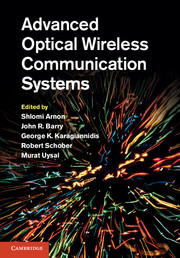Book contents
- Frontmatter
- Contents
- List of contributors
- Part I Outlook
- Part II Optical wireless communication theory
- 2 Coded modulation techniques for optical wireless channels
- 3 Wireless optical CDMA communication systems
- 4 Pointing error statistics
- 5 Equalization and Markov chains in cloud channel
- 6 Multiple-input multiple-output techniques for indoor optical wireless communications
- 7 Channel capacity
- Part III Unique channels
- Part IV Applications
- Index
3 - Wireless optical CDMA communication systems
from Part II - Optical wireless communication theory
Published online by Cambridge University Press: 05 June 2012
- Frontmatter
- Contents
- List of contributors
- Part I Outlook
- Part II Optical wireless communication theory
- 2 Coded modulation techniques for optical wireless channels
- 3 Wireless optical CDMA communication systems
- 4 Pointing error statistics
- 5 Equalization and Markov chains in cloud channel
- 6 Multiple-input multiple-output techniques for indoor optical wireless communications
- 7 Channel capacity
- Part III Unique channels
- Part IV Applications
- Index
Summary
Introduction
Amidst revolutionary communication technologies of recent decades such as optical fiber and wireless systems other forms of communication technologies are popping up in order to complete or complement the ever-increasing and insatiable need for communications links in today's society. Among many such niche technologies optical wireless communication technology, in particular, is begining to enjoy a wide range of applications and attention from many industries for short-range interchip applications to interplanetary space applications. Furthermore, optical wireless systems have attracted even further considerable growth in research and development since they can be appropriate alternatives for wireless or fiber-optic communication systems in some specific applications. Indoor wireless LANs, atmospheric optical links, and submarine optical wireless systems have grown in importance where lightwave communications is preferred to radio communications. This preference in various applications can be originated from security requirements, radio interference avoidance, no need for reserving frequency bands and cost of development [1]–[9].
In this chapter we study and analyze a particular and advanced form of optical wireless communication systems namely optical code-division multiple-access (OCDMA) in the context of wireless optical systems. As wireless optical communication systems get more mature and become viable for multi-user communication systems, advanced multiple-access techniques become more important and attractive in such systems. Among all multiple-access techniques in optical domain, OCDMA is of utmost interest because of its flexibility, ease of implementation, no need for synchronization among many users, and soft traffic handling capability.
Intensity modulation/direct detection (IM/DD) schemes are widely used in wireless optical applications. The interest in using IM/DD schemes stems from the fact that they can be easily implemented in transmitter and receiver sides.
Information
- Type
- Chapter
- Information
- Advanced Optical Wireless Communication Systems , pp. 54 - 86Publisher: Cambridge University PressPrint publication year: 2012
Accessibility standard: Unknown
Why this information is here
This section outlines the accessibility features of this content - including support for screen readers, full keyboard navigation and high-contrast display options. This may not be relevant for you.Accessibility Information
- 2
- Cited by
